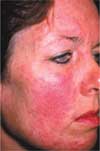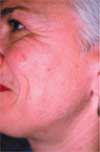Pustular Drug Reaction and Androgen-Induced Acne
An acneiform eruption, pruritic papules on the extremities, pustular scalp lesions--can you identify the disorders pictured here?

Case 1:
This 37-year-old woman presents for evaluation of a slowly worsening acneiform eruption on her face and trunk of 1 week's duration. She had started erythromycin 1 week earlier for an upper respiratory tract infection that resolved uneventfully. She is taking no other medications and denies any exposure history. She has not changed bathing habits or moisturizers.
What does this look like to you?
A. Acne.
B. Rosacea.
C. Pustular drug reaction.
D.Pityrosporum folliculitis.
E. Contact dermatitis.

Case 1: Erythromycin and other antibiotics are common causes of pustular drug reactions, C. Discontinuation of the antibiotic resulted in complete resolution of the rash.
It would be unusual to see acne this extensive without an obvious cause. The same is true of rosacea, especially because truncal involvement occurs infrequently with this condition. Facial involvement is uncommon in Pityrosporum folliculitis. Contact dermatitis is pruritic.

Case 2:
This 50-year-old woman has had acne for several months. She started hormone replacement therapy just before the outbreaks began, but she had not had any other eruptions since her teenage years. She takes no other medications and has not changed her cleansing routine or cosmetics.
What is your clinical impression?
A. Progesterone-induced acne.
B. Estrogen-induced acne.
C. Androgen-induced acne.
D. Rosacea.
E. Stress-induced acne.

Case 2:
The patient has
androgen-induced acne, C,
a result of the testosterone in the hormone replacement formulation. The dosage was lowered, and the outbreak resolved.
Some synthetic progestins can aggravate acne, although this more commonly occurs with oral contraceptives. Estrogen does not cause acne. If there were no obvious cause of the outbreak, rosacea would be included in the differential. Stress is more likely to produce a rosacealike outbreak than an acne eruption, especially in a patient who has not had acne in more than 30 years.


Case 3:
For several weeks, a 23-year-old woman has been bothered by pruritic acneiform lesions on her arms and legs. She has recently started lap swimming. The patient has a history of seasonal allergies, for which she takes loratadine. She has used the same oral contraceptive for years.
Which of the following do you suspect?
A. Staphylococcal folliculitis.
B. Gram-negative folliculitis.
C.Pityrosporum folliculitis.
D. Follicular eczema.
E. Acne.


Case 3: The patient has follicular eczema, D, an eruption of folliculocentric accentuated (ie, palpable) papules that is provoked by bathing habits (such as bathing more than once a day or frequent swimming); environment (such as using a loofah); or shaving habits (such as using a triple-edged razor). Treatment measures include avoidance of the initiating factor and use of a topical corticosteroid cream.
Staphylococcal and Gram-negative folliculitis are usually tender and more inflamed. Pityrosporum folliculitis generally erupts on the trunk and spares the extremities. Acne does not appear on the extremities because of a paucity of sebaceous activity.

Case 4:
Pruritic papules have appeared intermittently on the scalp of a 35-year-old man during the past few months. He denies any change in shampoo or hair-care products.
What is the most likely diagnosis?
A. Seborrheic folliculitis.
B. Acne.
C.Pityrosporum folliculitis.
D.Candida folliculitis.
E. Psoriasis.

Case 4:
The patient has
seborrheic folliculitis, A,
an extension of seborrheic dermatitis into the hair follicle that results in an acnelike eruption. These lesions respond to antifungal shampoos, corticosteroid shampoos, and oral tetracyclines.
Some dermatologists claim that acne can occur on the scalp; however, it would be unusual if the scalp were the only area of involvement. Because seborrhea is thought to be caused by Pityrosporum, choice C is technically correct, although the term Pityrosporum folliculitis is generally reserved for the monomorphous folliculitis seen on the trunk. Candida folliculitis is usually not seen on the scalp unless the patient is immunocompromised. Psoriasis does not produce pustules on the scalp without typical lesions elsewhere.